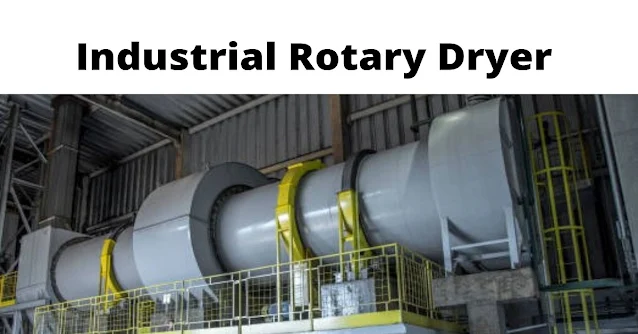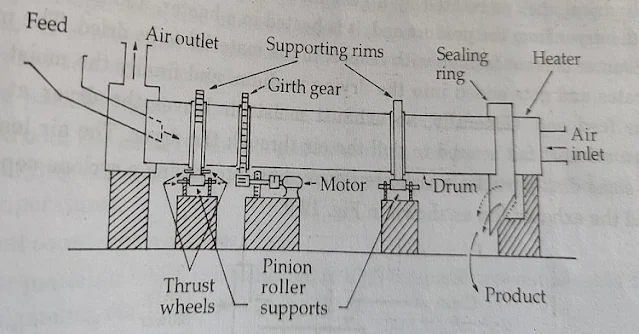A rotary dryer (that may be directly or indirectly heated) is adopted for the continuous drying of free-flowing granular materials on a large scale. Show one below a diagram(1.0) from a rotary dryer. It consists of a relatively long cylindrical shell (having a diameter of 1 meter to 3 meters and a length of 3 meters to 30 meters), set with its axis at an angle to the horizontal so that materials fed are consequently advanced through the dryer.
Construction and Working
The shell is mounted on rollers so that it can be rotated. To avoid slipping over the rollers, it is fitted with thrust wheels. It is fitted inside with which lift the material upward and shower it down from the top.
A few spiral flights are fitted near the feed end which helps in giving the initial forward motion to the material before principle flights are reached. The material to be dried is fed at the high end of the dryer by a hopper and the product is taken out from the lower end of the dryer. The material moves through the dryer by the rotation heat effect and slope of a cylindrical shell.
The cylindrical shell is rotated by a gear mechanism at a speed of 2 to 25 r.p.m. Air is taken into the dryer from the product's end, it is heated in a heater, and then motioned through the dryer in a counter fashion concerning the material to be dried. The moisture of the feed evaporates and gets added to the drying medium, and finally, the moist air leaves the dryer at the feed end. Generally, an exhaust fan is used to pull the air through the dryer. The air leaving the dryer will contain some dust particles which are removed by interposing a cyclone separator between the dryer and the exhaust fan as shown in the diagram.
Fig. 12.8
The mode of operation is usually continuous. In case of direct contact, the hot gas is passed over the material in a counter-current fashion. In the case of indirect contact, heat is transferred through the wall of the cylindrical shell.
The thermal efficiency of rotary dryers is about 50 - 80% and the drying rate ranges between 10 - 50Kg/h.m2 of shell volume.
Rotary dryer advantages and disadvantages
Rotary dryer Advantages
Good gas contacting
Moderate drying time
Low capital cost
Drying and calcining in the same unit
High thermal efficiency
Greater flexibility of control of gas velocity.
Rotary dryer Disadvantages
Difficulty of sealing
Product build-up on interior walls
High structural load
Non-uniform residence time.
Rotary dryers are grouped into four categories
Direct heat counter-current flow
This type of dryer is shown in fig. 12.8 and employed for materials that may be heated to a high temperature like minerals, sand clays, etc. Hot flue gas is used as the drying medium. It is also used for products like ammonium sulfate and cane sugar wherein the hot air is used as a drying medium.
Direct heat parallel flow
In this type both the material and hot gas/air move in the same direction through the dryer. It is used for drying materials like gypsum, iron, pyrites, etc., which should not be heated to destructive temperatures.
Indirect heat counter flow
It is used for material that can be heated to high temperatures out of contact with flue gas such as white pigments, etc. It is shown in fig. 12.10.
Direct-indirect type dryer
This type of dryer is used for solids, which may be heated to very high temperatures by flue gas, such as lignite, coal, and coke. It is shown in fig. 12.11. It contains an inner hollow tube through which the flue gas passes from a combustion chamber to the lower end of the dryer. At this end, the direction of flue gas is reversed and made to pass through hollow flights, through an annular space, and leaves the dryer from the feed end. The central tube is provided with longitudinal fins to increase the outer area of heat transfer.
The wet material is admitted at the high end of the dryer and travels down to the lower end and is taken out as a dried product. Air enters from the product end and travels over the solid in the reverse direction. The moisture gets added to the air and finally leaves the dryer from the feed end.
The material is heated indirectly by the flue gas by conduction and radiation and the moisture is taken out by air, flowing in a counter-current fashion with respect to the feed. Another type of indirect dryer is the steam tube dryer employing a number of tubes and finds applications where material must not be heated to a high temperature, e.g., drying of cattle feed, etc.
Take these Notes is, Orginal Sources: Unit Operations-II, KA Gavhane
More ......
Spray Dryer Construction, Working | Spray Dryer Advantages, and disadvantages






about rotary dryer working principle, this blog is so far the best article I ever read, as a rotary dryer manufacturer in China, we learn a lot from your information ,thank you for your detailed explain BANTI
ReplyDelete